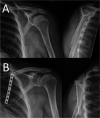Scapulothoracic tenodesis using hamstring tendon graft for treatment of problematic scapula winging: A new surgical technique
- PMID: 38818097
- PMCID: PMC11135188
- DOI: 10.1177/17585732231174178
Scapulothoracic tenodesis using hamstring tendon graft for treatment of problematic scapula winging: A new surgical technique
Abstract
Introduction: Winging of the scapula occurs due to dysfunction of its stabilising muscles, most commonly serratus anterior and/or trapezius, for example in facioscapulohumeral muscular dystrophy. Resultant loss of scapular control and abnormal kinematics can decrease shoulder function due to glenohumeral joint instability, loss of range of motion and pain. Previously described treatment for cases resistant to physiotherapy includes scapulothoracic arthrodesis which involves risk of non-union and metalwork failure, as well as reduced respiratory function due to immobilisation of a segment of the adjacent chest wall.
Technique: We present a novel surgical approach to the management of problematic scapular winging by using hamstring graft to achieve a scapulothoracic tenodesis.
Discussion: We believe this technique provides an adequately stable scapula for improved shoulder movement and function, a sufficiently mobile chest wall for improved lung function and avoidance of complications specifically associated with arthrodesis.
Keywords: Scapulothoracic tenodesis; facioscapulohumeral muscular dystrophy; hamstring graft; scapula winging; scapulothoracic arthrodesis.
© The Author(s) 2023.
Conflict of interest statement
The authors declared no potential conflicts of interest with respect to the research, authorship, and/or publication of this article.
Figures










Similar articles
-
Scapular fixation in muscular dystrophy.Cochrane Database Syst Rev. 2010 Jan 20;2010(1):CD003278. doi: 10.1002/14651858.CD003278.pub2. Cochrane Database Syst Rev. 2010. PMID: 20091543 Free PMC article.
-
Scapular fixation in muscular dystrophy.Cochrane Database Syst Rev. 2003;(3):CD003278. doi: 10.1002/14651858.CD003278. Cochrane Database Syst Rev. 2003. Update in: Cochrane Database Syst Rev. 2010 Jan 20;(1):CD003278. doi: 10.1002/14651858.CD003278.pub2. PMID: 12917959 Updated.
-
Treatment of neurogenic scapular winging: a systematic review on outcomes after nonsurgical management and tendon transfer surgery.J Shoulder Elbow Surg. 2023 Feb;32(2):e35-e47. doi: 10.1016/j.jse.2022.09.009. Epub 2022 Oct 15. J Shoulder Elbow Surg. 2023. PMID: 36252782
-
Reinforcement Reconstruction using Fascia Lata Autograft for Rhomboid Paralysis-Induced Scapular Winging.J Vis Exp. 2025 May 16;(219). doi: 10.3791/68253. J Vis Exp. 2025. PMID: 40455669
-
Surgical versus non-surgical interventions for displaced intra-articular calcaneal fractures.Cochrane Database Syst Rev. 2023 Nov 7;11(11):CD008628. doi: 10.1002/14651858.CD008628.pub3. Cochrane Database Syst Rev. 2023. PMID: 37933733 Free PMC article.
References
-
- Stübgen JP, Stipp A. Facioscapulohumeral muscular dystrophy: a prospective study of weakness and functional impairment. J Neurol 2010; 257: 1457–1464. - PubMed
-
- Krishnan SG, Hawkins RJ, Michelotti JD, et al. Scapulothoracic arthrodesis: indications, technique, and results. Clin Orthop Relat Res 2005; 435: 126–133. - PubMed
-
- Eren I, Ersen A, Birsel O, et al. Functional outcomes and complications following scapulothoracic arthrodesis in patients with facioscapulohumeral dystrophy. J Bone Joint Surg Am 2020; 102: 237–244. - PubMed
-
- Atasoy E, Majd M. Scapulothoracic stabilisation for winging of the scapula using strips of autogenous fascia lata. J Bone Joint Surg Br 2000; 82: 813–817. - PubMed
LinkOut - more resources
Full Text Sources
